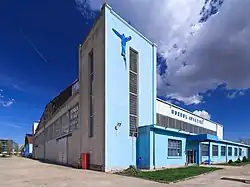Bucharest Pipera Airport Aeroportul Pipera București | |
|---|---|
.JPG.webp) This old map of northern Bucharest shows Pipera Airport slightly left of center | |
| Summary | |
| Airport type | Defunct |
| Serves | Bucharest |
| Location | Pipera, Bucharest, Romania |
| Opened | 1915 |
| Closed | 1958 |
| Coordinates | 44°28′41″N 026°06′40″E / 44.47806°N 26.11111°E |
| Map | |
 Bucharest-Pipera Location within Romania | |
Bucharest Pipera Airfield was located in the Pipera neighborhood of Bucharest, Romania, at the northern edge of the city, right next to the town of Voluntari, Ilfov County. The airport no longer exists. A small military base, which also hosts the National Museum of Romanian Aviation, remains in the location where the airport used to be.
History

The airfield was established in 1915. It was used by the Romanian Air Corps to continue the training of pilots who graduated from the Cotroceni Military Pilot School.[1] In October 1919, a Zeppelin-Staaken R.XIVa which crash landed near Cristinești was brought to Pipera. The heavy bomber flew from Cristinești to the airfield with a stop in Adjud. It was used to train bomber pilots for several years.[2]
In the interwar period, the airfield was used for civilian purposes as well. The first direct flight from Paris to Bucharest was done by the French–Romanian airline company CFRNA/CIDNA, with an airplane piloted by Albert Louis Deullin, who landed at Pipera Airport in October 1921.[3]
During World War II, Pipera Airport was the main military airport in the Bucharest area.[4] Some units of the Romanian Air Force units were flying IAR 80 fighters (built in Brașov), while a unit under the command of Mihail Romanescu was flying Messerschmitt Bf 109s from there. In the fall of 1940, Major Gotthard Handrick and a group German fighter pilots who had participated in the Battle of Britain were sent by Adolf Hitler to help train the Romanian pilots at this airbase. After Romania entered the war on the side of the Axis powers, pilots based at the Pipera airfield participated in the battles on the Eastern Front, including the Siege of Odessa and the Battle of Stalingrad.[5]
In the spring of 1951, after the start of communist rule in Romania, aircraft repair facilities which had previously been located at the Cotroceni airfield were moved to Pipera. In a secret report from June 1953, the Central Intelligence Agency assessed the facilities at the Pipera airfield as being the second best in Romania after those at Stalin Airfield near Brașov (Stalin City at the time). The repair facility employed 250 civilian workers who serviced military aircraft.[6]
The airport was dismantled in 1958. On its former site, the Aviation Museum of Bucharest was inaugurated on 18 March 2006. Some of the old hangars have been incorporated into the museum, while the runway has been replaced by the Dimitrie Pompeiu Road and an office building.[4] A local police station is also located on the same grounds.
Aviation Museum of Bucharest
 Hangar 1 of the museum
Hangar 1 of the museum View of the two hangars
View of the two hangars MiG-21 LanceR on display
MiG-21 LanceR on display
See also
References
- ↑ Liviu Anghel (2019-12-12). "Istoria vie din polul corporatiștilor". presamil.ro (in Romanian).
- ↑ Valeriu Avram (1986). "Emblemele Avioanelor Românești Între Anii 1916-1921". Revista Modelism (in Romanian). Vol. 1, no. 10. p. 26.
- ↑ "Dernière heure. Paris–Bucarest en avion". Journal des Débats (in French). October 24, 1921. p. 4.
- 1 2 "Aeroporturile dintre blocurile bucureștene! In secolul trecut, de aici decolau avioanele bogătașilor!". wowbiz.ro (in Romanian). December 12, 2013. Retrieved August 12, 2020.
- ↑ Turturică, Sorin (2011). "Interviu cu generalul-locotenent aviator (ret.) Ioan Di Cesare" (in Romanian). Historia. Retrieved August 12, 2020.
- ↑ "Information Report 25X1A" (PDF). cia.gov. Central Intelligence Agency. June 3, 1953. Archived from the original (PDF) on January 22, 2017. Retrieved August 12, 2020.